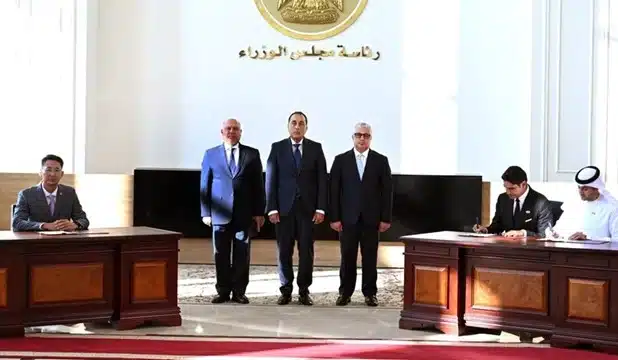Egypt’s new solar manufacturing facility targets 2GW annual production capacity across cells and modules while generating 841 jobs, yet the scale represents less than 1% of China’s current manufacturing dominance, which captured 98% of global solar wafer production and 92% of cell manufacturing as of 2023. The $220 million investment by Bahraini, Chinese, Egyptian, and Emirati partners positions the facility within broader efforts to reduce Chinese supply chain concentration, though market impact remains constrained by production volumes.
The Atom Solar Project’s location in New Alamein City’s Sokhna Industrial Zone within the Suez Canal Economic Zone provides logistical advantages for both export and regional distribution, yet faces established competition from Chinese manufacturers that have achieved substantial economies of scale through integrated supply chains and government support mechanisms.
Production Strategy Reflects Market Segmentation Approach
The facility’s bifurcated strategy—directing solar cells toward global export markets while supplying modules to domestic and regional Middle Eastern and African markets—acknowledges different competitive dynamics across the value chain. Cell production for export targets countries seeking supply chain diversification away from Chinese manufacturing, though price competitiveness against established Asian producers remains unproven.
Module assembly for regional markets capitalizes on proximity advantages and potential trade barriers, favoring local production. Egypt’s domestic solar deployment requirements create baseline demand, while neighboring African markets have demonstrated 60% year-on-year growth in Chinese solar panel imports according to Ember, indicating substantial regional appetite that could support local manufacturing.
The inclusion of 1GWh battery energy storage system production addresses growing energy storage demand across the Middle East and Africa, though this capacity represents modest scale compared to established Asian manufacturers. Battery production requires different technical capabilities and supply chains than solar manufacturing, potentially complicating operational integration and capital efficiency.
Partnership Structure Balances Regional Capabilities
The consortium combines JA Solar’s manufacturing expertise with regional financial and operational partners, reflecting recognition that technology transfer and market access require local partnerships. JA Solar’s involvement provides technical credibility, having supplied modules to Egypt’s 500MW Abydos Solar project integrated with 300MWh battery storage from Trina Storage.
Infinity Capital’s Bahraini backing and Global South Utilities’ UAE headquarters suggest Gulf state investment in Egyptian manufacturing capacity, potentially supported by regional development finance institutions. Egyptian partner AH Industrial Management’s component repair background may provide maintenance and service capabilities rather than core manufacturing expertise.
The three-year construction and trial operation timeline indicates substantial facility complexity requiring specialized equipment installation and workforce training. This duration aligns with typical solar manufacturing facility development schedules but extends the market entry timeline while Chinese manufacturers continue expanding capacity.
Supply Chain Localization Strategy Faces Material Constraints
Egypt’s commitment to “gradually increase” local content using domestic aluminum and glass resources addresses supply chain resilience while reducing import dependencies. However, solar cell manufacturing requires specialized materials, including silicon wafers, silver paste, and anti-reflective coatings that Egypt does not currently produce at a commercial scale.
The facility’s 2GW cell production capacity requires substantial silicon wafer inputs that currently originate primarily from Chinese manufacturers. Without upstream polysilicon and wafer production, the facility remains dependent on Chinese supply chains for core materials, limiting strategic autonomy benefits.
Module assembly offers greater localization potential through aluminum frames, glass covers, and packaging materials available from Egyptian suppliers. However, critical components, including inverters, tracking systems, and electrical components, typically require imports from specialized manufacturers concentrated in Asia and Europe.
Regional Competition Intensifies Manufacturing Landscape
The project joins EliTe Solar’s planned 8GW facility in the same Suez Canal Economic Zone, creating potential cluster effects while intensifying regional competition. The combined 10GW planned capacity between both facilities represents significant regional manufacturing ambition, though market absorption capacity across Middle Eastern and African markets requires validation.
Singaporean EliTe Solar’s larger scale suggests more substantial capital commitment and potentially lower unit costs through economies of scale. Competition between facilities could pressure pricing and market share allocation, particularly in limited domestic and regional markets.
The concentration of solar manufacturing projects in the Suez Canal Economic Zone indicates the Egyptian government’s strategic planning to create industrial clusters with shared infrastructure and logistics advantages. However, cluster success depends on sufficient market demand, skilled workforce availability, and supply chain integration.
Market Access Challenges Threaten Commercial Viability
Export market success for Egyptian-produced cells requires price competitiveness against Chinese manufacturers that benefit from integrated supply chains, government subsidies, and massive production scales. Recent trade tensions and tariff implementations in various markets create opportunities for non-Chinese suppliers, though cost gaps remain substantial.
Regional module sales face competition from Chinese manufacturers that have demonstrated ability to serve African markets with competitive pricing despite transportation costs. Egypt’s proximity advantage may not offset manufacturing cost disadvantages without trade protection or preferential procurement policies.
The facility’s 2GW annual capacity represents modest scale compared to leading Chinese manufacturers that operate facilities exceeding 10GW annual production. Scale disadvantages typically translate to higher unit costs unless offset by automation, labor cost advantages, or supply chain optimizations.
Technology Transfer and Innovation Capacity Remain Unclear
JA Solar’s partnership role suggests technology transfer arrangements that could build Egyptian manufacturing capabilities, though specific intellectual property sharing and technical training provisions remain undisclosed. Successful technology transfer requires sustained technical cooperation and local workforce development beyond initial facility construction.
The facility’s ability to adapt to evolving solar cell technologies, including advanced passivated emitter and rear cell (PERC) designs and emerging topcon and heterojunction architectures, depends on ongoing technology partnerships and capital investment capabilities. Technological obsolescence risks increase for facilities lacking research and development capabilities.
Battery manufacturing integration requires different technical competencies than solar cell production, potentially straining management focus and capital allocation. Successful multi-technology facilities require specialized expertise across distinct manufacturing processes and supply chains.
The Egyptian government’s job creation estimate of 841 positions suggests substantial employment impact for the local region while requiring skilled workforce development in specialized manufacturing processes. Training programs and technical education partnerships will determine workforce capability development and facility operational success.





